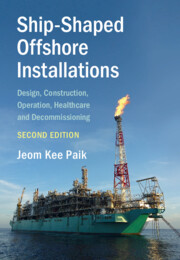Book contents
- Ship-Shaped Offshore Installations
- Cambridge Ocean Technology Series
- Ship-Shaped Offshore Installations
- Copyright page
- Contents
- Preface to the Second Edition
- Preface to the First Edition
- 1 Introduction to Ship-Shaped Offshore Installations
- 2 Structural Steel Selection and Construction
- 3 Ocean Environmental Conditions
- 4 Site-Specific Wave-Induced Hull Girder Loads
- 5 Serviceability Limit States
- 6 Fatigue Limit States
- 7 Ultimate Limit States
- 8 Accidental Limit States
- 9 Mooring System Engineering
- 10 Sloshing Impact Engineering
- 11 Seismic Impact Engineering
- 12 Aircraft Impact Engineering
- 13 Quantitative Risk Assessment and Management
- 14 Life-Cycle Corrosion Assessment and Management
- 15 Lifetime Healthcare and Safe Decommissioning
- Book part
- Index
- References
3 - Ocean Environmental Conditions
Published online by Cambridge University Press: 27 January 2022
- Ship-Shaped Offshore Installations
- Cambridge Ocean Technology Series
- Ship-Shaped Offshore Installations
- Copyright page
- Contents
- Preface to the Second Edition
- Preface to the First Edition
- 1 Introduction to Ship-Shaped Offshore Installations
- 2 Structural Steel Selection and Construction
- 3 Ocean Environmental Conditions
- 4 Site-Specific Wave-Induced Hull Girder Loads
- 5 Serviceability Limit States
- 6 Fatigue Limit States
- 7 Ultimate Limit States
- 8 Accidental Limit States
- 9 Mooring System Engineering
- 10 Sloshing Impact Engineering
- 11 Seismic Impact Engineering
- 12 Aircraft Impact Engineering
- 13 Quantitative Risk Assessment and Management
- 14 Life-Cycle Corrosion Assessment and Management
- 15 Lifetime Healthcare and Safe Decommissioning
- Book part
- Index
- References
Summary
Criteria that are relevant to the safety engineering of ship-shaped offshore installations are influenced by ocean environmental conditions that affect the transit, operation, survival and decommissioning of these installations. The actions of ocean environmental conditions on ship-shaped offshore installations are different from their actions on trading ships. Particularly, the nature and operation of the former mean that the structures are substantially affected by the action of waves, winds and currents, whereas the latter are primarily affected by waves only. Thus, accurate and efficient modelling of ocean environmental conditions at the proposed sites of ship-shaped offshore installations is essential for safety engineering and long operational uptimes.
- Type
- Chapter
- Information
- Ship-Shaped Offshore InstallationsDesign, Construction, Operation, Healthcare and Decommissioning, pp. 81 - 110Publisher: Cambridge University PressPrint publication year: 2022

